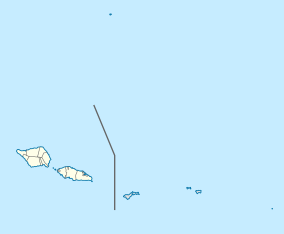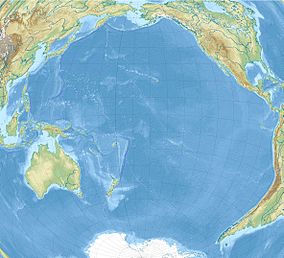| O Le Pupu-Puʿe National Park | |
|---|---|
| IUCN category II (national park) | |
 Aerial view of the O Le Pupū lava cliffs, Samoa Aerial view of the O Le Pupū lava cliffs, Samoa | |
  | |
| Location | Upolu, Samoa |
| Nearest city | Apia |
| Coordinates | 13°59′S 171°43′W / 13.983°S 171.717°W / -13.983; -171.717 |
| Area | 50.2 km (19.4 sq mi) |
| Established | 1978 |
| Governing body | Ministry of Natural Resources and Environment |
O Le Pupu-Puʿe National Park ("The Cliffs-Mountain") is the oldest national park in Samoa. Established in 1978, the park covers 5019 hectares of the southern-central portion of the island of Upolu on the border of the Atua and Tuamasaga districts. The park extends from Mount Fito, the highest mountain on Uplou, to the coast, and includes uplands, valleys, marshes, the O Le Pupu lava field, and coastal cliffs. In 2016 it was designated as a wetland of international importance under the Ramsar Convention.
History
The park was established in 1978 under the authority of the National Parks and Reserves Act 1974. Originally covering 2800 hectares, the park was later expanded to 4234 hectares. In 2008 an adjoining forestry project was incorporated, as well as the Togitogiga Recreational Reserve, expanding the park to 5019 hectares.
The park was initially managed by the Forestry Division of the Ministry of Agriculture, Forestry, Fisheries and Meteorology. In 1989 control was passed to the Lands, Surveys and Environment Department. In 2005, it was transferred again, to the Ministry of Natural Resources and Environment.
Ecology
The park extends from Mount Fito and Mount Le Pu’e on Upolu's central ridge to the coast, taking in the entire range of forest types found on Upolu. It includes areas of montane and lowland forest as well as littoral vegetation. 352 native plant species have been recorded in the park, representing half of Samoa's native plant-life. 51 animal species have been recorded, including the Samoa flying fox, Insular flying fox, and Pacific sheath-tailed bat. The Pacific boa is also believed to be present, and remains were found in the park in 2018.
In the wake of cyclones Ofa and Val 10% of the park area has been taken over by the invasive Merremia plant.
References
- ^ Ian G. Trotman (1979). "Western Samoa Launches a National Park Program" (PDF). Parks. 3 (4): 5–8. Retrieved 5 August 2021.
- Bellingham, Mark; Davis, Alison (1988). "FOREST BIRD COMMUNITIES IN WESTERN SAMOA" (PDF). Notornis. 35: 118–119. Retrieved 5 August 2021.
- "The "O Le Pūpū Puē National Park" established in 1978, now Internationally Protected as a Wetland of International Importance, 'Ramsar Site'". Ministry of Natural Resources and Environment. Retrieved 5 August 2021.
- "O Le Pupū Puē National Park". Ramsar Sites Information Service. Retrieved 5 August 2021.
- "Samoan National Park makes Global list". Samoa Observer. 11 October 2017. Retrieved 5 August 2021.
- Arthur L. Dahl (1980). "Regional ecosystems survey of the South Pacific area" (PDF). South Pacific Commission. p. 59. Retrieved 5 August 2021.
- ^ "O Le Pupu-Puʿe National Park Management Plan (Ramsar Site) 2020 - 2030" (PDF). Ministry of Natural Resources and Environment. 25 February 2021. Retrieved 5 August 2021.
- ^ "O LE PUPŪ-PU'E NATIONAL PARK MANAGEMENT PLAN 2010-2014" (PDF). Ministry of Natural Resources and Environment. 30 July 2010. p. 11. Retrieved 5 August 2021.
- Adel Fruean (1 November 2018). "Tracker finds snake in national park". Samoa Observer. Retrieved 5 August 2021.
- Gutu Faasau (11 June 2023). "Fighting the Merremia at Samoa's oldest park". Samoa Observer. Retrieved 11 June 2023.